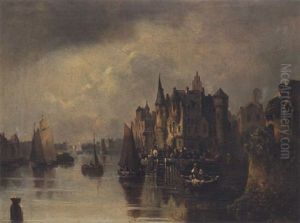Alexander Zick Paintings
Alexander Zick was a notable German painter and illustrator, born on December 20, 1845, in Koblenz, Germany. He came from a family deeply entrenched in the arts; his grandfather, Johann Zick, was a well-regarded fresco painter, and his father, Johannes Zick, was also a talented artist. This lineage provided Alexander with a rich artistic heritage and an environment that nurtured his talents from a young age. He embarked on his artistic education at the Düsseldorf Academy, a prestigious institution known for its influence on German painting and sculpture in the 19th century. There, Zick was exposed to the academic art training that was pivotal in shaping his artistic direction.
Zick's artistic oeuvre is characterized by a deep interest in Germanic myths, legends, and fairy tales, subjects that became significantly popular in the 19th century as part of the Romantic movement's fascination with folklore and national identity. His illustrations often brought these stories to life with vivid detail and a dynamic use of color, capturing the imagination of both children and adults. In addition to his book illustrations, Zick also engaged in mural painting, executing large-scale works that often depicted historical and mythological scenes. His murals, found in public buildings and private residences, were celebrated for their intricate detail and compositional mastery.
Throughout his career, Zick also contributed to the applied arts, designing stained glass windows, mosaics, and furniture, showcasing his versatility as an artist. His work in these areas reflected the broader 19th-century interest in Gesamtkunstwerk, or 'total work of art', which sought to unify different art forms into cohesive wholes.
Alexander Zick passed away on November 10, 1907, in Berlin, but his legacy endures through his contributions to the world of illustration and mural painting. His work remains a testament to the richness of German folklore and the 19th-century artistic movements that celebrated cultural heritage and storytelling. Zick's illustrations, in particular, continue to be cherished for their enchanting depictions of fairy tales, securing his place in the annals of art history as a beloved illustrator and painter.



